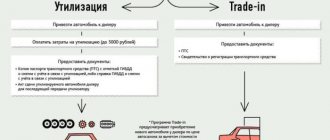Vehicles may be subject to arrest to exclude the possibility of performing registration and formalities with them until the owner repays existing financial debts and executes the relevant court decisions. The purpose of these restrictive measures is to prevent illegal sales, as well as concealment of the car or its destruction. Sometimes they can be supplemented by a ban on the operation of the car with subsequent seizure or transfer to a third party for safekeeping.
The removal of a seizure from a car imposed by bailiffs is carried out in the manner determined for each specific case by current legislation. In any case, the main condition is that the debtor fulfills all existing obligations, including compensation for expenses incurred by third parties during this administrative process. This applies to paid state fees, legal costs and other expenses, the repayment of which is carried out at the expense of the defendant.
How to find out if a car is seized?
Information about restrictive or interim measures taken in relation to a specific vehicle can be obtained online.
You can obtain information about restrictive measures regarding a vehicle for free - on the page https://www.gibdd.ru/check/auto/#wanted (this is the official website of the State Traffic Inspectorate). The tools are simple and clear, the information of interest is displayed with a few mouse clicks in a maximum of a couple of minutes. The check is carried out based on the entered VIN code or body/chassis identification number (these details are available in the vehicle registration documents). You will also need to enter a security code (captcha). Click the "Request Review" link in the "Check for Restrictions" section and the relevant machine details will be displayed on the screen.
You can also check whether it is necessary to remove the arrest from the car by personally contacting any traffic police department. In addition, this information is provided by the department of the Federal Bailiff Service, located at the place of registration of the owner of the vehicle. If there are restrictions regarding the machine, this body is obliged to notify about this, indicating the reasons that became the basis for making the corresponding decision.
If there is information about the place of registration of the car owner and his full name, you can obtain information about the presence/absence of restrictions on the vehicle on the official website of the FSSP at https://fssprus.ru/iss/ip. This contains the most current information, including those that have not yet entered the State Traffic Inspectorate database.
How to remove a seizure from a car imposed by a bailiff
What restrictions may a car owner face?
The main and legally established restriction on the disposal of a car is its arrest. The owner of a seized vehicle cannot be unaware of these penalties. As a rule, the reason for arrest is unpaid debts, the most varied, from loans, taxes and fines for traffic violations to alimony and utility payments.
Articles / Popular questions What traffic violations can lead to jail time? Everyone knows that the most unpleasant punishment for a driver for violating traffic rules is deprivation of his license. But at the same time, this is not the most serious of the penalties applied to violators: for some... 8191 0 15 08/13/2018
The use of seizure of the debtor's property is determined by Part 1 of Article 80 of Federal Law No. 229 “On Enforcement Proceedings”. At the same time, part 4 of this article clarifies that arrest does not always mean seizure or restriction of the right to use property (including a car), but the debtor no longer has the right to dispose of it - that is, sell, re-register, donate, and so on. Some unscrupulous citizens take advantage of this by selling a seized car that has not been seized or has not been subject to restrictions on the right to use.
Please note: Part 1.1 of the same Federal Law No. 229 specifies that “the seizure of the debtor’s property under an executive document containing a demand for the recovery of funds is not permitted if the amount of recovery under enforcement proceedings does not exceed 3,000 rubles.”
In addition, the documents contain the wording “prohibition on registration actions”: in particular, in part 3 of section I of the Rules for state registration of cars in the State Traffic Safety Inspectorate, approved by Order No. 399, it is said that “they are not subject to registration with the State Traffic Inspectorate and registration actions are not carried out with vehicles means” if “in relation to the vehicle, in accordance with the legislation of the Russian Federation, prohibitions and (or) restrictions on the performance of registration actions are imposed.” In fact, for the car owner this means the same thing: the inability to sell it until the reasons for the ban are eliminated.
How to remove a lien from a car?
To remove a seizure from a car, you need to follow three logical steps: find out the reasons for the seizure, eliminate them or prove their illegality, and then contact the authority that imposed the restrictions to cancel them.
In practice it looks like this. Having learned about the arrest or other restrictions, you need to find out which body made this decision - as a rule, this is the FSSP (Federal Bailiff Service). Using a special service on the official website of the FSSP, you can obtain data on existing enforcement proceedings by indicating personal data. For more detailed information, you can contact the FSSP office in person.
The second step is to eliminate the reasons for the seizure. As a rule, these are unpaid debts - that is, to eliminate them, you need to pay all the debts specified in the enforcement proceedings, and then present receipts for payment to the bailiff. However, there are also erroneous orders to seize property - for example, in relation to the owner of a car, whose last name, first name and patronymic completely coincide with the debtor’s data. In this case, you need to contact the FSSP department and notify the bailiffs about the error or go to court if the issue is not resolved pre-trial.
The result of solving the problem with the seizure of the car should be a decision on the completion or termination of enforcement proceedings. Also, the FSSP must transmit to the traffic police information about the lifting of the “ban on registration actions” within one day. However, in practice this may take longer, so it is worth obtaining a copy of the resolution to provide to the inspector if the seizure needs to be lifted as soon as possible (for example, to sell a car).
How not to buy a seized car?
To protect yourself from buying a seized car, you must thoroughly check it before purchasing. To begin with, you should do this on the official website of the traffic police: here, by indicating the VIN of the car, you can get information about the presence of restrictions, and at the same time check the registration history, participation in an accident and being on the wanted list. But sometimes information about the presence of restrictions is not transmitted to the traffic police too quickly, so it is also worth checking the car owner for the presence of existing enforcement proceedings on the official website of the FSSP. Well, in addition, it is worth finding out whether the car you are buying is pledged (for example, with a bank): this can be done on the official website of the Federal Notary Chamber, indicating the VIN.
Who can seize a vehicle?
In most cases, vehicles are seized by the Federal Bailiff Service. Customs authorities can also seize the car: this is done in case of non-compliance with customs clearance rules, non-payment of due payments, other mandatory fees, including imposed financial sanctions. In addition, the seizure of vehicles is possible on the initiative of other organizations if there is a corresponding decision of the judicial authority.
In any case, after this it is prohibited to carry out any registration actions with the car: registration/deregistration with the State Traffic Inspectorate, donation, sale, re-registration, etc.
It should be understood that the traffic police does not seize vehicles. Many people confuse this restrictive measure with the forced evacuation of an illegally parked car. This is a common misconception, since in the latter case we are not talking about a ban on registration and other actions (re-registration, purchase/sale, etc.). After paying the fine imposed by the traffic police and, if necessary, paying off other debts (for example, for impound area services), the car can be picked up at any time. As such, the seizure of the car does not take place in this case; it is simply returned to the owner or his legal representative.
Legislative aspect
The bailiff service decides to seize the vehicle if there is a corresponding court verdict. The reason is the owner’s failure to fulfill his financial obligations, including:
- alimony;
- bank loans (this applies not only to the amount of debt, but also to interest due, as well as other obligatory payments to the financial institution);
- fines imposed by the traffic police and other government agencies;
- taxes and mandatory non-tax payments;
- debts for utilities, etc.
After the court issues a decree to seize a vehicle, bailiffs are obliged to inform the owner of the car, as well as the relevant government agencies, about this.
Then, within a month from the date of discovery of the debtor’s property, the bailiff must find a professional appraiser to determine the real value of the seized assets in accordance with current market realities. Current legislation provides for a period of one week to a month to carry out the assessment. No later than 3 days from the moment of receiving information from the appraiser, the bailiff must issue a decision on the assessment.
If the seizure of the vehicle is not removed within the prescribed period, then after evaluation it must be transferred to a specialized organization for sale within 10 days. If the deadlines provided by law are not met, the claimant has the right to appeal the behavior of the bailiffs to their managers or in court.
In civil and arbitration proceedings
In civil proceedings, property may be seized:
- in the order of interim measures taken during the consideration of the case by the court (Article 91 of the Arbitration Procedure Code of the Russian Federation, Article 140 of the Code of Civil Procedure of the Russian Federation);
- in enforcement proceedings in relation to property subject to foreclosure (Articles 80 - 83 of the Federal Law “On Enforcement Proceedings”).
Expert opinion
Lawyer Alexander Vasiliev comments
The imposition of an interim measure is carried out by a ruling of the court considering the case (Article 93 of the Arbitration Procedure Code of the Russian Federation). It is permissible to apply restrictions only to property belonging to the defendant, which is in his possession or in the possession of other persons (Resolution of the Plenum of the Supreme Arbitration Court of the Russian Federation of October 12, 2006 No. 55 “On the application of interim measures by arbitration courts”). An application to secure a claim in the form of seizure of property is subject to a state fee.
The amounts of state duty are established by the Tax Code of the Russian Federation:
- 3000 rubles in the arbitration process (clause 9, clause 1, article 333.21 of the Tax Code of the Russian Federation);
- in a court of general jurisdiction, there is no state fee when filing an application to secure a claim (with the exception of an application to secure an arbitration court decision, which is subject to a state fee of 300 rubles - subclause 12, clause 1, article 333.19 of the Tax Code of the Russian Federation).
Additionally, the court may request the provision of counter security in the form of a transfer of funds to the court's deposit account or otherwise (Article 94 of the Arbitration Procedure Code of the Russian Federation, Article 146 of the Code of Civil Procedure of the Russian Federation).
In enforcement proceedings, arrest is imposed upon execution of a judicial act on the seizure of the property of the defendant, administrative defendant, located in his possession or in the possession of third parties (Part 1, Clause 5, Part 3, Article 68 of the Federal Law “On Enforcement Proceedings”). The bailiff makes an arrest within the framework specified in the court decision.
Is it possible to remove the arrest from a car?
It is possible to remove restrictive measures on a vehicle, but the process depends on the specifics of the specific situation.
For example, in the case of purchasing a car that was seized, if restrictive measures were imposed after its acquisition and execution of the transaction, to remove the seizure from the car, it is enough to submit an application to the bailiffs, attaching the original or a certified copy of the contract. If they refuse to remove the encumbrances from the vehicle, you should go to court with a claim to release the car from seizure.
If the car was seized before the purchase and sale agreement was signed, the only option to solve the problem is to go to court with a request to invalidate the concluded transaction. This will give the buyer the right to recover from the seller the money paid for the vehicle.
As for other grounds for removing restrictive measures from a vehicle, these are:
- completion of enforcement proceedings according to the initiative of the claimant;
- availability of documentary evidence of the debtor’s liquidation of existing obligations (payment of fines, repayment of debts on utility or tax payments, etc.);
- making a court decision on the unlawful seizure of a vehicle;
- termination of enforcement proceedings in accordance with the relevant court ruling.
Information about the removal of the seizure from the car is indicated in the resolution on the completion of enforcement proceedings.
Grounds for lifting arrest
Sample statement of claim to remove the seizure of a car from the traffic police
Let us outline how to remove the arrest from a car from bailiffs. It is important to meet one of the conditions. These are the grounds on which an arrest can be lifted.
- It is possible to terminate enforcement proceedings at the initiative of the claimant himself.
- The debtor's fulfillment of all requirements of the writ of execution (debt repayment, payment of fines, penalties, fees) has been confirmed.
- A court decision may also be made regarding the unlawful seizure of the debtor's property.
- Enforcement proceedings were terminated according to the court's request.
The Resolution on the completion of enforcement proceedings indicates information about the cancellation of the seizure of the vehicle.
How to find out if a car has been seized?
Information can be obtained from any department of the State Traffic Inspectorate, as well as on the traffic police website.
To prevent your car from being seized, pay on time. Vehicles may be seized to exclude the possibility of registration and formalities with them until the owner repays existing financial debts and the relevant court decisions are executed. The purpose of these restrictive measures is to prevent illegal sales, as well as concealment of the car or its destruction. Sometimes they can be supplemented by a ban on the operation of the car with subsequent seizure or transfer to a third party for safekeeping.
The removal of a seizure from a car imposed by bailiffs is carried out in the manner determined for each specific case by current legislation. In any case, the main condition is that the debtor fulfills all existing obligations, including compensation for expenses incurred by third parties during this administrative process. This applies to paid state fees, legal costs and other expenses, the repayment of which is carried out at the expense of the defendant.
The amount of state duty when removing the seizure from a car through the court
How to remove a lien from an engine if it is registered with the previous owner of the vehicle?
My husband bought a used car in 1989. My brother is the guarantor of the loan for five hundred thousand.
The house has been seized. This is the only housing in which our mother lives. The house was bought with her money, but registered in the name of her brother. Before the hearing on the loan, the judge seized my apartment.
By decision of the presidium of the regional court, this decision was canceled. How can I remove the arrest from an apartment? In order to secure the claim, the apartment was arrested (at the plaintiff’s request for interim measures, there was a separate court ruling) I have the following question: 01/22/09 I bought a car deregistered from a citizen (A) he had a general power of attorney from the owner with all rights, vol. I had 2 apartments that were seized.
Particular importance when considering a claim is attached to the following documents:
How to find out if a car is seized?
Information about restrictive or interim measures taken in relation to a specific vehicle can be obtained online.
You can obtain information about restrictive measures regarding a vehicle for free - on the page https://www.gibdd.ru/check/auto/#wanted (this is the official website of the State Traffic Inspectorate). The tools are simple and clear, the information of interest is displayed with a few mouse clicks in a maximum of a couple of minutes. The check is carried out based on the entered VIN code or body/chassis identification number (these details are available in the vehicle registration documents). You will also need to enter a security code (captcha). Click the "Request Review" link in the "Check for Restrictions" section and the relevant machine details will be displayed on the screen.
You can also check whether it is necessary to remove the arrest from the car by personally contacting any traffic police department. In addition, this information is provided by the department of the Federal Bailiff Service, located at the place of registration of the owner of the vehicle. If there are restrictions regarding the machine, this body is obliged to notify about this, indicating the reasons that became the basis for making the corresponding decision.
If there is information about the place of registration of the car owner and his full name, you can obtain information about the presence/absence of restrictions on the vehicle on the official website of the FSSP at https://fssprus.ru/iss/ip. This contains the most current information, including those that have not yet entered the State Traffic Inspectorate database.
Who can seize a vehicle?
In most cases, vehicles are seized by the Federal Bailiff Service. Customs authorities can also seize the car: this is done in case of non-compliance with customs clearance rules, non-payment of due payments, other mandatory fees, including imposed financial sanctions. In addition, the seizure of vehicles is possible on the initiative of other organizations if there is a corresponding decision of the judicial authority.
In any case, after this it is prohibited to carry out any registration actions with the car: registration/deregistration with the State Traffic Inspectorate, donation, sale, re-registration, etc.
It should be understood that the traffic police does not seize vehicles. Many people confuse this restrictive measure with the forced evacuation of an illegally parked car. This is a common misconception, since in the latter case we are not talking about a ban on registration and other actions (re-registration, purchase/sale, etc.). After paying the fine imposed by the traffic police and, if necessary, paying off other debts (for example, for impound area services), the car can be picked up at any time. As such, the seizure of the car does not take place in this case; it is simply returned to the owner or his legal representative.
Legislative aspect
The bailiff service decides to seize the vehicle if there is a corresponding court verdict. The reason is the owner’s failure to fulfill his financial obligations, including:
- alimony;
- bank loans (this applies not only to the amount of debt, but also to interest due, as well as other obligatory payments to the financial institution);
- fines imposed by the traffic police and other government agencies;
- taxes and mandatory non-tax payments;
- debts for utilities, etc.
After the court issues a decree to seize a vehicle, bailiffs are obliged to inform the owner of the car, as well as the relevant government agencies, about this.
Then, within a month from the date of discovery of the debtor’s property, the bailiff must find a professional appraiser to determine the real value of the seized assets in accordance with current market realities. Current legislation provides for a period of one week to a month to carry out the assessment. No later than 3 days from the moment of receiving information from the appraiser, the bailiff must issue a decision on the assessment.
If the seizure of the vehicle is not removed within the prescribed period, then after evaluation it must be transferred to a specialized organization for sale within 10 days. If the deadlines provided by law are not met, the claimant has the right to appeal the behavior of the bailiffs to their managers or in court.
Is it possible to remove the arrest from a car?
It is possible to remove restrictive measures on a vehicle, but the process depends on the specifics of the specific situation.
For example, in the case of purchasing a car that was seized, if restrictive measures were imposed after its acquisition and execution of the transaction, to remove the seizure from the car, it is enough to submit an application to the bailiffs, attaching the original or a certified copy of the contract. If they refuse to remove the encumbrances from the vehicle, you should go to court with a claim to release the car from seizure.
If the car was seized before the purchase and sale agreement was signed, the only option to solve the problem is to go to court with a request to invalidate the concluded transaction. This will give the buyer the right to recover from the seller the money paid for the vehicle.
As for other grounds for removing restrictive measures from a vehicle, these are:
- completion of enforcement proceedings according to the initiative of the claimant;
- availability of documentary evidence of the debtor’s liquidation of existing obligations (payment of fines, repayment of debts on utility or tax payments, etc.);
- making a court decision on the unlawful seizure of a vehicle;
- termination of enforcement proceedings in accordance with the relevant court ruling.
Information about the removal of the seizure from the car is indicated in the resolution on the completion of enforcement proceedings.
Is it possible to carry out the procedure?
Arrest is a measure that should ensure the protection of the interests of the plaintiff. The imposition is regulated by Art. 27.14 Code of Administrative Offenses of the Russian Federation, as well as Art. 77 Tax Code of the Russian Federation, Art. 115 of the Code of Criminal Procedure of the Russian Federation, as well as a number of other regulations.
In most cases, a vehicle that has once been seized cannot be sold, donated, scrapped, or otherwise transferred to another person or deregistered. However, there are exceptions to this rule:
- the purchase and sale agreement was concluded before the property became seized (read about whether it is possible to deregister a car sold under a sale and purchase agreement from the traffic police register to the former owner here);
- the security measure was imposed illegally;
- the grounds for imposing such a security measure have already expired (for example, if the debt has already been repaid).
Important! The new owner needs to know: how, when and by whom his property was seized. Without this, he will not be able to remove the restrictions imposed on the registration of the car.
In 2013, by Order of the Ministry of Internal Affairs of the Russian Federation, changes were made to the rules for registering vehicles. On our website you will find a complete list of grounds for deregistration of a car, find out how long you can use the car after deregistration, what the cost of this procedure is, how to correctly draw up an application to the traffic police and a power of attorney, what other documents are needed from individuals and legal entities, as well as how to terminate registration in another city or region, without the presence of a car, through the State Services portal.








